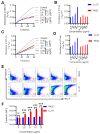Identification and Characterization of RK22, a Novel Antimicrobial Peptide from Hirudinaria manillensis against Methicillin Resistant Staphylococcus aureus
- PMID: 37686259
- PMCID: PMC10487658
- DOI: 10.3390/ijms241713453
Identification and Characterization of RK22, a Novel Antimicrobial Peptide from Hirudinaria manillensis against Methicillin Resistant Staphylococcus aureus
Abstract
Staphylococcus aureus (S. aureus) infections are a leading cause of morbidity and mortality, which are compounded by drug resistance. By manipulating the coagulation system, S. aureus gains a significant advantage over host defense mechanisms, with hypercoagulation induced by S. aureus potentially aggravating infectious diseases. Recently, we and other researchers identified that a higher level of LL-37, one endogenous antimicrobial peptide with a significant killing effect on S. aureus infection, resulted in thrombosis formation through the induction of platelet activation and potentiation of the coagulation factor enzymatic activity. In the current study, we identified a novel antimicrobial peptide (RK22) from the salivary gland transcriptome of Hirudinaria manillensis (H. manillensis) through bioinformatic analysis, and then synthesized it, which exhibited good antimicrobial activity against S. aureus, including a clinically resistant strain with a minimal inhibitory concentration (MIC) of 6.25 μg/mL. The RK22 peptide rapidly killed S. aureus by inhibiting biofilm formation and promoting biofilm eradication, with good plasma stability, negligible cytotoxicity, minimal hemolytic activity, and no significant promotion of the coagulation system. Notably, administration of RK22 significantly inhibited S. aureus infection and the clinically resistant strain in vivo. Thus, these findings highlight the potential of RK22 as an ideal treatment candidate against S. aureus infection.
Keywords: Hirudinaria manillensis; RK22; Staphylococcus aureus; antimicrobial peptide.
Conflict of interest statement
The authors declare no conflict of interest.
Figures




Similar articles
-
Efficacy of antimicrobial peptide LL-37 against biofilm forming Staphylococcus aureus strains obtained from chronic wound infections.Microb Pathog. 2022 Jan;162:105368. doi: 10.1016/j.micpath.2021.105368. Epub 2021 Dec 20. Microb Pathog. 2022. PMID: 34942309
-
Efficacy of Cathelicidin-Mimetic Antimicrobial Peptoids against Staphylococcus aureus.Microbiol Spectr. 2022 Jun 29;10(3):e0053422. doi: 10.1128/spectrum.00534-22. Epub 2022 Apr 25. Microbiol Spectr. 2022. PMID: 35467395 Free PMC article.
-
Antibacterial and antibiofilm activities of Mayan medicinal plants against Methicillin-susceptible and -resistant strains of Staphylococcus aureus.J Ethnopharmacol. 2021 Oct 28;279:114369. doi: 10.1016/j.jep.2021.114369. Epub 2021 Jun 26. J Ethnopharmacol. 2021. PMID: 34186100
-
Correlation Between Biofilm Formation and Antibiotic Resistance in MRSA and MSSA Isolated from Clinical Samples in Iran: A Systematic Review and Meta-Analysis.Microb Drug Resist. 2020 Sep;26(9):1071-1080. doi: 10.1089/mdr.2020.0001. Epub 2020 Mar 10. Microb Drug Resist. 2020. PMID: 32159447
-
Therapeutic applications of lysostaphin against Staphylococcus aureus.J Appl Microbiol. 2021 Sep;131(3):1072-1082. doi: 10.1111/jam.14985. Epub 2021 Jan 18. J Appl Microbiol. 2021. PMID: 33382154 Review.
Cited by
-
Peptide Toxin Diversity and a Novel Antimicrobial Peptide from the Spider Oxyopes forcipiformis.Toxins (Basel). 2024 Oct 31;16(11):466. doi: 10.3390/toxins16110466. Toxins (Basel). 2024. PMID: 39591221 Free PMC article.
-
Blap-6, a Novel Antifungal Peptide from the Chinese Medicinal Beetle Blaps rhynchopetera against Cryptococcus neoformans.Int J Mol Sci. 2024 May 14;25(10):5336. doi: 10.3390/ijms25105336. Int J Mol Sci. 2024. PMID: 38791374 Free PMC article.
-
Progress in the Identification and Design of Novel Antimicrobial Peptides Against Pathogenic Microorganisms.Probiotics Antimicrob Proteins. 2025 Apr;17(2):918-936. doi: 10.1007/s12602-024-10402-4. Epub 2024 Nov 18. Probiotics Antimicrob Proteins. 2025. PMID: 39557756 Free PMC article. Review.
-
Genetic Variation and Gene Expression of the Antimicrobial Peptide Macins in Asian Buffalo Leech (Hirudinaria manillensis).Biology (Basel). 2025 May 8;14(5):517. doi: 10.3390/biology14050517. Biology (Basel). 2025. PMID: 40427706 Free PMC article.
References
-
- Vella V., Galgani I., Polito L., Arora A.K., Creech C.B., David M.Z., Lowy F.D., Macesic N., Ridgway J.P., Uhlemann A.C., et al. Staphylococcus aureus Skin and Soft Tissue Infection Recurrence Rates in Outpatients: A Retrospective Database Study at 3 US Medical Centers. Clin. Infect. Dis. Off. Publ. Infect. Dis. Soc. Am. 2021;73:e1045–e1053. doi: 10.1093/cid/ciaa1717. - DOI - PMC - PubMed
MeSH terms
Substances
Grants and funding
- 2022YFC2105003/National Key Research and Development Program of China
- U2002219/National Natural Science Foundation of China
- KFJ-BRP-008-003 and SAJC202103/Chinese Academy of Sciences
- 202003AD150008 and 202302AA310035/Yunnan Provincial Science and Technology Department
- 2022SCP007/Kunming Science and Technology Bureau
LinkOut - more resources
Full Text Sources
Medical

